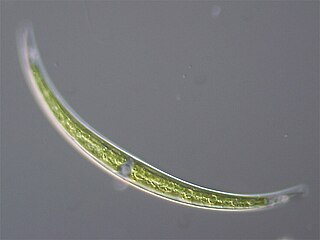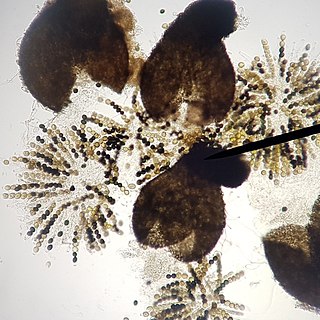
Cryptococcus is a genus of fungi in the family Cryptococcaceae that includes both yeasts and filamentous species. The filamentous, sexual forms or teleomorphs were formerly classified in the genus Filobasidiella, while Cryptococcus was reserved for the yeasts. Most yeast species formerly referred to Cryptococcus have now been placed in different genera. The name Cryptococcus comes from the Greek for "hidden sphere". Some Cryptococcus species cause a disease called cryptococcosis.
Dermatophyte is a common label for a group of fungus of Arthrodermataceae that commonly causes skin disease in animals and humans. Traditionally, these anamorphic mold genera are: Microsporum, Epidermophyton and Trichophyton. There are about 40 species in these three genera. Species capable of reproducing sexually belong in the teleomorphic genus Arthroderma, of the Ascomycota. As of 2019 a total of nine genera are identified and new phylogenetic taxonomy has been proposed.

Aspergillus is a genus consisting of several hundred mould species found in various climates worldwide.

Neurospora is a genus of Ascomycete fungi. The genus name, meaning "nerve spore" refers to the characteristic striations on the spores that resemble axons.

Aspergillus nidulans is one of many species of filamentous fungi in the phylum Ascomycota. It has been an important research organism for studying eukaryotic cell biology for over 50 years, being used to study a wide range of subjects including recombination, DNA repair, mutation, cell cycle control, tubulin, chromatin, nucleokinesis, pathogenesis, metabolism, and experimental evolution. It is one of the few species in its genus able to form sexual spores through meiosis, allowing crossing of strains in the laboratory. A. nidulans is a homothallic fungus, meaning it is able to self-fertilize and form fruiting bodies in the absence of a mating partner. It has septate hyphae with a woolly colony texture and white mycelia. The green colour of wild-type colonies is due to pigmentation of the spores, while mutations in the pigmentation pathway can produce other spore colours.

Fungi are a diverse group of organisms that employ a huge variety of reproductive strategies, ranging from fully asexual to almost exclusively sexual species. Most species can reproduce both sexually and asexually, alternating between haploid and diploid forms. This contrasts with most multicellular eukaryotes such as mammals, where the adults are usually diploid and produce haploid gametes which combine to form the next generation. In fungi, both haploid and diploid forms can reproduce – haploid individuals can undergo asexual reproduction while diploid forms can produce gametes that combine to give rise to the next generation.

The Mucorales is the largest and best-studied order of zygomycete fungi. Members of this order are sometimes called pin molds. The term mucormycosis is now preferred for infections caused by molds belonging to the order Mucorales.

The fungal genus Cochliobolus includes 19 species, it includes some plant pathogenic species such as Cochliobolus heterostrophus. A lot of former Cochliobolus species were transferred to either Curvularia or Bipolaris genera.
Pythium ultimum is a plant pathogen. It causes damping off and root rot diseases of hundreds of diverse plant hosts including corn, soybean, potato, wheat, fir, and many ornamental species. P. ultimum belongs to the peronosporalean lineage of oomycetes, along with other important plant pathogens such as Phytophthora spp. and many genera of downy mildews. P. ultimum is a frequent inhabitant of fields, freshwater ponds, and decomposing vegetation in most areas of the world. Contributing to the widespread distribution and persistence of P. ultimum is its ability to grow saprotrophically in soil and plant residue. This trait is also exhibited by most Pythium spp. but not by the related Phytophthora spp., which can only colonize living plant hosts.
Huntiella moniliformis is a saprobic fungal species that was previously accommodated in the Ceratocystis genus. Due to morphological, molecular and ecological differences, it was recently allocated to the newly described Huntiella genus. Species belonging to this genus typically do not cause disease on plants with the exception of H. bhutanensis. These species are almost always found on freshly cut timber or wounded trees.
Aphanomyces raphani, also known as Radish black root disease, is a fungal plant pathogen of various species of Brassicaceae. It is a necrotrophic pathogen causing small black water soaked lesions on its hosts which become rapidly colonised by other fungi and bacteria.
Septoria humuli is a fungal plant pathogen infecting the hop plant.
Septoria lactucae, or lettuce septoria blight, is a pathogenic leaf fungus that is found on lettuce.
Phacidiopycnis padwickii is a species of fungus in the family Phacidiaceae, first described by Kavasji Framaji Kheswalla in 1941. It is a plant pathogen that causes collar rot, foot rot, wilt and blight of chickpea.

Closterium is a genus of desmid, a group of charophyte green algae. It is placed in the family Closteriaceae. Species of Closterium are a common component of freshwater microalgae flora worldwide.

Sordaria macrospora is a species of coprophilous (dung-colonizing) fungus. It is one of several fungal model organisms in biology, e.g. the model of fruiting body development in Ascomycetes. It is a homothallic, self-fertile organism.

A fungus is any member of the group of eukaryotic organisms that includes microorganisms such as yeasts and molds, as well as the more familiar mushrooms. These organisms are classified as one of the traditional eukaryotic kingdoms, along with Animalia, Plantae and either Protista or Protozoa and Chromista.
Homothallic refers to the possession, within a single organism, of the resources to reproduce sexually; i.e., having male and female reproductive structures on the same thallus. The opposite sexual functions are performed by different cells of a single mycelium.
Rhizomucor pusillus is a species of Rhizomucor. It can cause disease in humans. R. pusillus is a grey mycelium fungi most commonly found in compost piles. Yellow-brown spores grow on a stalk to reproduce more fungal cells.
Autogamy, or self-fertilization, refers to the fusion of two gametes that come from one individual. Autogamy is predominantly observed in the form of self-pollination, a reproductive mechanism employed by many flowering plants. However, species of protists have also been observed using autogamy as a means of reproduction. Flowering plants engage in autogamy regularly, while the protists that engage in autogamy only do so in stressful environments.









